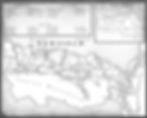Five Worldbuilding Questions to Jumpstart Your Fantasy Maps
- MD Presley
- Mar 22, 2022
- 3 min read
How do you go about creating a fictional world? It all starts with questions. Lots and lots of questions. In order to build your world, you need to know what it looks like, how it works, and what makes it unique. But before you go sketching out your continental drift or looking learning mapmaking rules, these five questions will help fantasy authors know what they need to get started.
And I’ve got one thing most other how to lists don’t: the data to back it up, all based on surveys of what fans want out of a fantasy map. And feel free to check out my video at the bottom, where I explain it all over at Forging Fantasy Realms.
Do you even need a map?
Authors are fairly split on the inclusion of fantasy maps, with Mark Lawrence avoiding them in particular. Audiences certainly understand if an author doesn’t want to include one, with 88% saying a fantasy story doesn’t need a map.
HOWEVER, 87% of fans enjoy when maps are included, with maps and myths being tied for the favorite ancillary inclusion.

And audiences love looking at them, with 61% saying they look at maps five times or more, with most of that happening in the first half of the story. Only 2.5% say they NEVER look at a map.
To those authors who fear they will say something in the text that the map will contradict, which the audience will always hold against them, know that 78% of audiences believe the text of the story takes precedence over the map.
And also know that Tolkien himself went back to edit the travel times in The Hobbit so they would match the LOTR maps. So if you make a mistake, you’re still in good company.

What Subgenre Are You Writing In?
Fantasy fans are unequivocal in their love of large maps, with world, continent, and region being the top choices of maps they’d like to see.

That said, it all depends on the subgenre the author is working in, with audiences expecting smaller maps for heist, steampunk, urban, and paranormal stories. This makes sense when we think in terms of the inside-out process audiences use when ingesting worldbuilding details: they only want what pertains to the story at hand. So if your story is set in a city, there’s no reason to include a map of the continent.

What Level of Realism?
Cartography is daunting, which is why people spend their lives dedicated to the craft. This is also another hat the fantasy author has to wear for their stories, and we want to get all the details right. But do we really need to?
Tolkien may have invented his own believable Elvish language, but the square shaped mountains around Mordor definitely don’t adhere to the laws of nature. And while we’re at it, Mr. Doom is also a little on the nose.
Fortunately, only 28% of audiences expect the maps to adhere to the real world geographies. This is fantasy, after all.

That said, please check out the resources section if you’d like some pointers for making a more realistic fantasy map.
What Level of Detail?

There’s a temptation to only include locations that appear within the story itself, but this leaves the map feeling rather barren and sterile. Maps are meant to guide people, after all, so it makes sense that 79% of audiences expect the map to include locations that don’t appear in the story itself. This is an example of the Illusion of Completeness, which ties back to the four Cs of worldbuilding in that the world feels like it exists before the story begins as well as extends beyond where the story takes place in. This makes the story feel more lived in and vivid.
What Medium?
There are already a lot of worldbuilding tools for building a fantasy map, including Inkarnate and AutoREALM, which I used to build my original maps of Ayr. There are also loads of fantasy cartographers out there, like Soyara, who designed my final map.

That said, you don’t have to be tied down to the traditional flat fantasy map. The Intuits of Greenland famously use carved driftwood to emulate the shorelines on their trips. Cosmological maps are also common and refreshing. It’s also possible to include non-objective maps, in either the medieval style (which were in no way accurate), or even personalized maps, like in The Traitor Baru Cormorant.
Spurred on by these, decide if you need to begin mapping out your world by creating different regions, drawing borders, and populating each area with settlements and landmarks. The more you fill out your map, the more your world will come to life. And if you’d like to know more, check out my in-depth video on the worldbuilding questions to ask before beginning your fantasy maps.



























